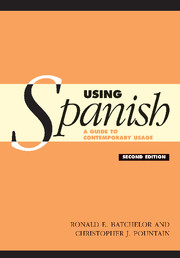Book contents
- Frontmatter
- Contents
- Authors' acknowledgements
- Preface to the second edition
- List of abbreviations and symbols
- Glossary
- The Spanish speaking world: countries where Spanish is spoken, with an estimate of the numbers of native speakers
- 1 Introduction
- 2 Passages illustrating register and local variety
- Part I Vocabulary
- 3 Misleading similarities between Spanish and English
- 4 Similarities between Spanish words
- 5 Fields of meaning – vocabulary extension
- 6 Complex verbal expressions
- 7 Affective suffixes
- 8 Idioms, similes and proverbs
- 9 Proper names
- 10 Adjectives pertaining to countries and towns
- 11 Abbreviations
- 12 Latin expressions
- 13 Anglicisms
- 14 Grammatical terms
- 15 Interjections
- 16 Fillers
- 17 Transition words
- 18 Numerals
- 19 Measurements
- 20 Semi-technical vocabulary
- Part II Grammar
- Index
18 - Numerals
Published online by Cambridge University Press: 05 June 2012
- Frontmatter
- Contents
- Authors' acknowledgements
- Preface to the second edition
- List of abbreviations and symbols
- Glossary
- The Spanish speaking world: countries where Spanish is spoken, with an estimate of the numbers of native speakers
- 1 Introduction
- 2 Passages illustrating register and local variety
- Part I Vocabulary
- 3 Misleading similarities between Spanish and English
- 4 Similarities between Spanish words
- 5 Fields of meaning – vocabulary extension
- 6 Complex verbal expressions
- 7 Affective suffixes
- 8 Idioms, similes and proverbs
- 9 Proper names
- 10 Adjectives pertaining to countries and towns
- 11 Abbreviations
- 12 Latin expressions
- 13 Anglicisms
- 14 Grammatical terms
- 15 Interjections
- 16 Fillers
- 17 Transition words
- 18 Numerals
- 19 Measurements
- 20 Semi-technical vocabulary
- Part II Grammar
- Index
Summary
Spanish uses a comma (coma) where English uses the decimal point, and a dot where English uses a comma in partitioning thousands. Thus Spanish 29,107 (veintinueve coma uno cero siete) = English 29.107 (twenty-nine point one zero seven), and Spanish 7.654.321 (siete millones, seiscientos cincuenta y cuatro mil, trescientos veintiuno) = English 7,654,321 (seven million, six hundred and fifty-four thousand, three hundred and twenty-one).
Spanish practice with telephone numbers varies. It is increasingly common now to read the digits one by one, as in English, so 00 34 9412568 is cero cero tres cuatro nueve cuatro uno dos cinco seis ocho. More traditionally the digits are paired off as far as possible: 412568 is often written 41 25 68 or 41.25.68 and read cuarenta y uno, veinticinco, sesenta y ocho, and when there is an odd number of digits in the number, the first is given in isolation: eg 369 47 11 is tres sesenta y nueve, cuarenta y siete, once. There is quite a range of possibilities with longer numbers, so 00 34 9412568 can be read cero cero treinta y cuatro novecientos cuarenta y uno veinticinco sesenta y ocho or cero cero treinta y cuatro noventa y cuatro doce quinientos sesenta y ocho.
- Type
- Chapter
- Information
- Using SpanishA Guide to Contemporary Usage, pp. 241Publisher: Cambridge University PressPrint publication year: 2005



